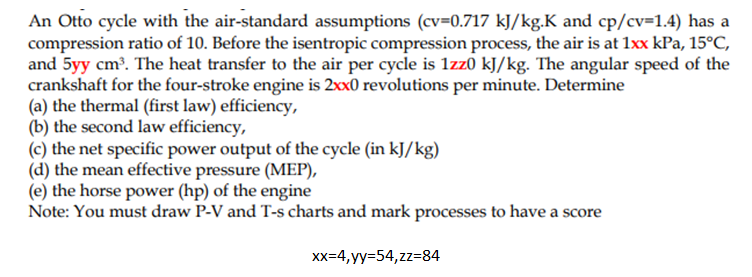An Otto cycle with the air-standard assumptions (cv=0.717 kJ/kg.K and cp/cv=1.4) has a compression ratio of 10. Before the isentropic compression process, the air is at 1xx kPa, 15°C, and 5yy cm³. The heat transfer to the air per cycle is 1zz0 kJ/kg. The angular speed of the crankshaft for the four-stroke engine is 2xx0 revolutions per minute. Determine (a) the thermal (first law) efficiency, (b) the second law efficiency, (c) the net specific power output of the cycle (in kJ/kg) (d) the mean effective pressure (MEP), (e) the horse power (hp) of the engine Note: You must draw P-V and T-s charts and mark processes to have a score Xx=4, yy=54,zz=84
An Otto cycle with the air-standard assumptions (cv=0.717 kJ/kg.K and cp/cv=1.4) has a compression ratio of 10. Before the isentropic compression process, the air is at 1xx kPa, 15°C, and 5yy cm³. The heat transfer to the air per cycle is 1zz0 kJ/kg. The angular speed of the crankshaft for the four-stroke engine is 2xx0 revolutions per minute. Determine (a) the thermal (first law) efficiency, (b) the second law efficiency, (c) the net specific power output of the cycle (in kJ/kg) (d) the mean effective pressure (MEP), (e) the horse power (hp) of the engine Note: You must draw P-V and T-s charts and mark processes to have a score Xx=4, yy=54,zz=84
Elements Of Electromagnetics
7th Edition
ISBN:9780190698614
Author:Sadiku, Matthew N. O.
Publisher:Sadiku, Matthew N. O.
ChapterMA: Math Assessment
Section: Chapter Questions
Problem 1.1MA
Related questions
Question

Transcribed Image Text:An Otto cycle with the air-standard assumptions (cv=0.717 kJ/kg.K and cp/cv=1.4) has a
compression ratio of 10. Before the isentropic compression process, the air is at 1xx kPa, 15°C,
and 5yy cm. The heat transfer to the air per cycle is 1zz0 kJ/kg. The angular speed of the
crankshaft for the four-stroke engine is 2xx0 revolutions per minute. Determine
(a) the thermal (first law) efficiency,
(b) the second law efficiency,
(c) the net specific power output of the cycle (in kJ/kg)
(d) the mean effective pressure (MEP),
(e) the horse power (hp) of the engine
Note: You must draw P-V and T-s charts and mark processes to have a score
Xx=4, yy=54,zz=84
Expert Solution
This question has been solved!
Explore an expertly crafted, step-by-step solution for a thorough understanding of key concepts.
Step by step
Solved in 7 steps with 12 images

Knowledge Booster
Learn more about
Need a deep-dive on the concept behind this application? Look no further. Learn more about this topic, mechanical-engineering and related others by exploring similar questions and additional content below.Recommended textbooks for you

Elements Of Electromagnetics
Mechanical Engineering
ISBN:
9780190698614
Author:
Sadiku, Matthew N. O.
Publisher:
Oxford University Press

Mechanics of Materials (10th Edition)
Mechanical Engineering
ISBN:
9780134319650
Author:
Russell C. Hibbeler
Publisher:
PEARSON

Thermodynamics: An Engineering Approach
Mechanical Engineering
ISBN:
9781259822674
Author:
Yunus A. Cengel Dr., Michael A. Boles
Publisher:
McGraw-Hill Education

Elements Of Electromagnetics
Mechanical Engineering
ISBN:
9780190698614
Author:
Sadiku, Matthew N. O.
Publisher:
Oxford University Press

Mechanics of Materials (10th Edition)
Mechanical Engineering
ISBN:
9780134319650
Author:
Russell C. Hibbeler
Publisher:
PEARSON

Thermodynamics: An Engineering Approach
Mechanical Engineering
ISBN:
9781259822674
Author:
Yunus A. Cengel Dr., Michael A. Boles
Publisher:
McGraw-Hill Education

Control Systems Engineering
Mechanical Engineering
ISBN:
9781118170519
Author:
Norman S. Nise
Publisher:
WILEY

Mechanics of Materials (MindTap Course List)
Mechanical Engineering
ISBN:
9781337093347
Author:
Barry J. Goodno, James M. Gere
Publisher:
Cengage Learning

Engineering Mechanics: Statics
Mechanical Engineering
ISBN:
9781118807330
Author:
James L. Meriam, L. G. Kraige, J. N. Bolton
Publisher:
WILEY